- What is a Public Cloud Firewall?
-
What Makes a Strong Firewall?
- User Identification and Access Management
- Credential Theft and Abuse Mitigation
- Application and Control Function Safety
- Encrypted Traffic Security
- Advanced Threat Defense and Cyberattack Prevention
- Mobile Workforce Protection
- Cloud Environment Security Enhancement
- Management Centralization and Security Capability Integration
- Task Automation and Threat Prioritization
- Strong Firewall FAQs
-
What Is Firewall Management? | A Comprehensive Guide
- Why is firewall management important?
- What are the main types of firewalls?
- What are the key components of firewall management?
- Who should be responsible for managing firewalls?
- What are the main firewall management challenges?
- Top 6 best practices for firewall management
- How to choose the right firewall management system for your needs
- Firewall management FAQs
- What Is Firewall Configuration? | How to Configure a Firewall
- What Is an Internal Firewall?
- What Is a Stateful Firewall? | Stateful Inspection Firewalls Explained
- What is a Software Firewall?
- What Is a Proxy Firewall? | Proxy Firewall Defined & Explained
- What Is a Perimeter Firewall?
- What Is a Packet Filtering Firewall?
- What Is a Host-Based Firewall?
- What Is a Hardware Firewall? Definition & Explanation
- What Is a Distributed Firewall?
- What Does a Firewall Do? | How Firewalls Work
- What Are the Benefits of a Firewall?
- What Are Firewall Rules? | Firewall Rules Explained
- Types of Firewalls Defined and Explained
- Layer 3 vs Layer 7 Firewall: What Are the Differences?
-
How to Troubleshoot a Firewall | Firewall Issues & Solutions
- What are the most common firewall issues?
- How to troubleshoot a firewall
- Step 1: Know your troubleshooting tools
- Step 2: Audit your firewall
- Step 3: Identify the issue
- Step 4: Determine traffic flow
- Step 5: Address connectivity issues
- Step 6: Resolve performance issues
- Step 7: Maintain your firewall
- Why firewall testing is critical and how to do it
- Step 1: Review firewall rules
- Step 2: Assess firewall policies
- Step 3: Verify access control lists (ACLs)
- Step 4: Perform configuration audits
- Step 5: Conduct performance testing
- Step 6: Log and monitor traffic
- Step 7: Validate rule effectiveness
- Step 8: Check for policy compliance
- Firewall troubleshooting tips, tricks, and best practices
- Firewall issues FAQs
-
The History of Firewalls | Who Invented the Firewall?
- Firewall History Timeline
- Ancient History-1980s: Firewall Predecessors
- 1990s: First Generation of Firewalls—Packet Filtering Firewalls
- Early 2000s: Second Generation of Firewalls—Stateful Firewalls
- 2008: Third Generation of Firewalls—Next-Generation Firewalls
- 2020: Fourth Generation of Firewalls—ML-Powered NGFWs
- History of Firewalls FAQs
-
Hardware Firewalls vs. Software Firewalls
- What Is a Hardware Firewall and How Does It Work?
- Benefits of Hardware Firewalls
- What Is a Software Firewall and How Does It Work?
- Benefits of Software Firewalls
- What Are the Differences Between Hardware Firewalls & Software Firewalls?
- Hardware vs. Software Firewalls
- What Are the Similarities Between Hardware Firewalls & Software Firewalls?
- Hardware Firewalls vs. Software Firewalls FAQs
-
IPS. vs. IDS vs. Firewall: What Are the Differences?
- What Is a Firewall?
- What Is an Intrusion Detection System (IDS)?
- What Is an Intrusion Prevention System (IPS)?
- What Are the Differences Between a Firewall, IDS, and IPS?
- What Are the Similarities Between a Firewall, IDS, and IPS?
- Can a Firewall and IDS or IPS Work Together?
- IDS vs. IPS vs. Firewall FAQs
-
Key Firewall Best Practices
- Harden and Configure Firewalls Properly
- Adopt a Customized, Phased Deployment Strategy
- Enhance and Regularly Update Firewall Protocols
- Ensure Rigorous Traffic Control
- Regularly Review and Update Access Controls
- Implement a Comprehensive Logging and Alert Mechanism
- Establish Backup and Restoration Protocols
- Align Policies with Compliance Standards
- Subject Firewalls to Regular Testing
- Conduct Routine Firewall Audits
- FAQs
-
What Are the Top Firewall Features? | Traditional & NGFWs
- How do firewalls work?
- What are the main traditional firewall features?
- Packet filtering
- Stateful inspection
- Network address translation (NAT)
- Logging and monitoring
- Access control
- What are the main next-generation firewall (NGFW) features?
- Advanced threat prevention
- Advanced URL filtering
- DNS security
- IoT security
- Next-generation CASB
- Firewall features FAQs
- What Is Firewall as a Service (FWaaS)? | A Complete Guide
- What Is a Virtual Firewall?
- What Is a Container Firewall?
-
3 Virtual Firewall Use Cases
What Is a Network Firewall?
A network firewall is a security device that filters traffic between a trusted internal network and untrusted external networks.
Network firewalls operate by inspecting incoming and outgoing data packets against a set of security rules and permitting or denying passage. This process ensures only safe and authorized data enters or leaves the network, which safeguards the integrity and confidentiality of internal network systems.
Why Are Network Firewalls Important?
Network firewalls are important because they serve as the first line of defense in network security. They actively manage the ingress and egress of network traffic to prevent unauthorized access. By establishing a set of robust security rules, firewalls effectively delineate and protect the boundary between internal corporate resources and the unsecured public internet.
How Does a Network Firewall Work?
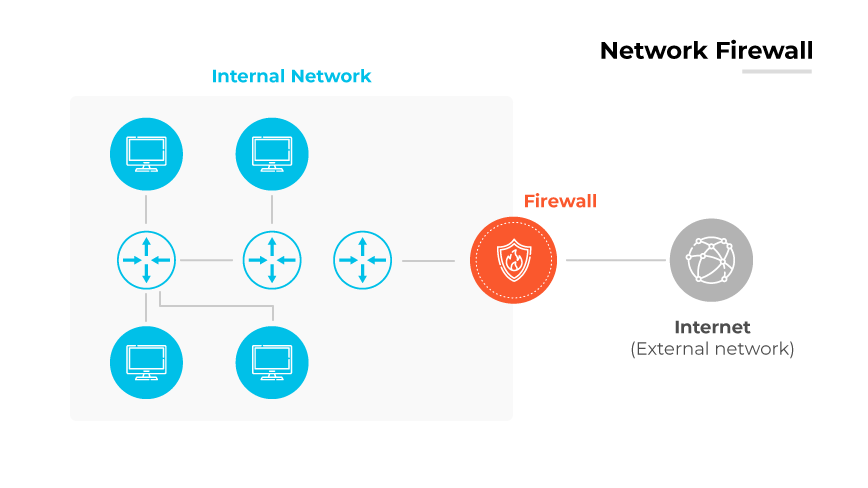
A network firewall operates as the gatekeeper at the boundary between secure internal networks and potentially insecure external networks. Network firewalls are available in software or hardware firewall form factors.
Their primary function is to analyze network packets against a set of established rules, determining which packets can enter or leave the network. Rule-based scrutiny enables the firewall to allow safe data to pass while blocking potentially malicious traffic.
Modern network firewalls have evolved to offer more than just basic packet filtering, often including features like Network Address Translation (NAT), which allows multiple devices on a local network to share a single public IP address. Network firewalls can also prioritize traffic to ensure the smooth functioning of sensitive applications, such as prioritizing VoIP data over email to prevent communication delays.
In addition to managing access based on IP addresses and ports, modern firewalls can inspect the data within packets. Deep packet inspection (DPI) allows firewalls to filter content, thwart malicious data packets, and protect against cyberattacks.
Network Firewall Features
Access Control
Network firewalls enforce access privileges, a fundamental aspect of maintaining a secure network environment. By adopting a 'deny by default' approach, modern network firewalls typically align with Zero Trust security models that assume no traffic is trusted, which significantly reduces risk.
Data Protection
Data protection limits access to sensitive information. They prevent unauthorized entities from reaching critical data, safeguarding confidential information such as financial records and personal data against unauthorized disclosure.
Traffic Monitoring
Traffic monitoring is another fundamental feature of network firewalls. By monitoring data transfers, network firewalls can identify and neutralize risks, allowing network administrators to adjust security settings in response to observed traffic patterns.
Intrusion Prevention System (IPS)
The role of firewalls in preventing system hijacking is critical. They serve as a deterrent to cybercriminals by blocking access to network resources.
Threat Prevention
Network firewalls act as a crucial line of defense against malware, spyware, adware, etc. As technological complexity increases, so do the potential entry points for these threats, which network firewalls help to seal off.
Types of Network Firewalls
Packet Filtering Firewall
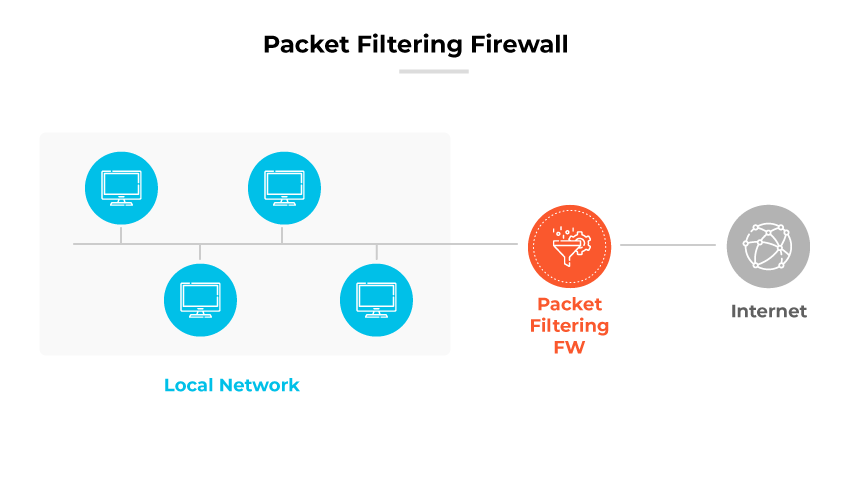
Packet filtering firewalls operate at the network layer to control access to data based on a set of rules. These rules are applied to data packets and their attributes such as IP addresses and ports, determining whether the packets are allowed through the network.
Stateful Inspection Firewall
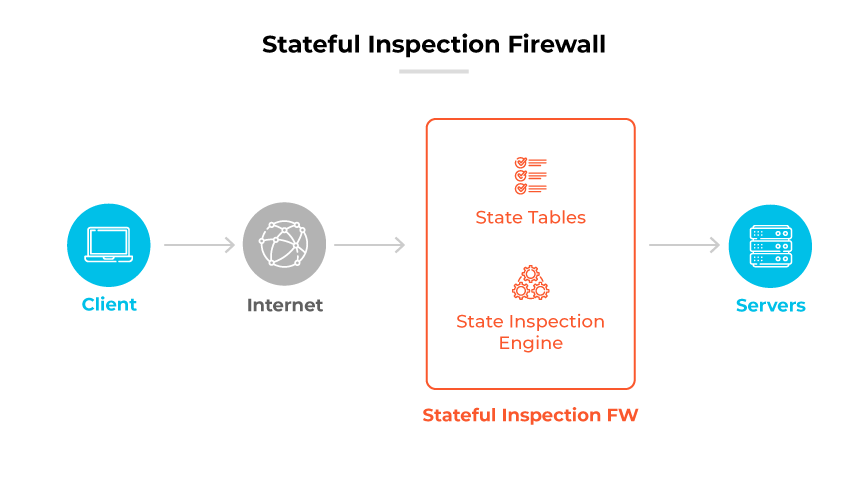
Stateful inspection firewalls provide a more sophisticated level of protection by monitoring the state of active network connections. They inspect both the header information and the state of packets, enabling them to make more informed decisions about which traffic to allow or deny.
Proxy Firewall
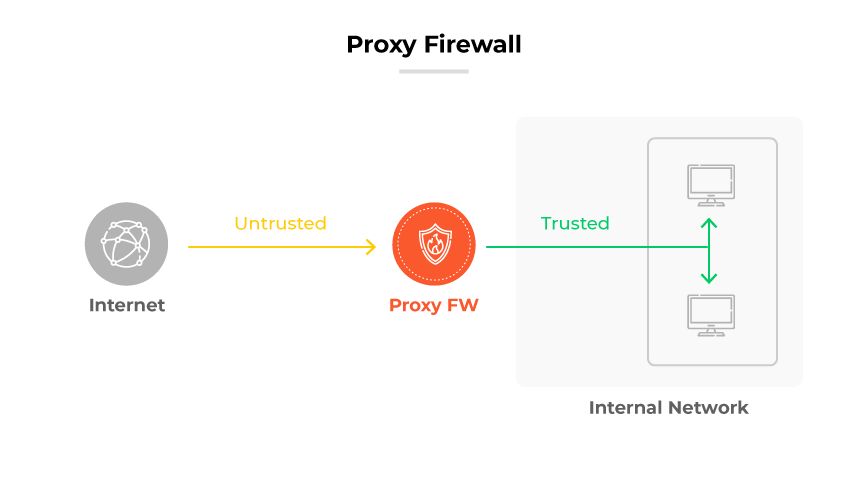
Proxy firewalls act as intermediaries between users and the services they access. By handling requests on behalf of users, they provide a high level of data security and privacy, filtering messages at the application layer and preventing direct connections from outside the network.
Circuit-Level Gateway

Circuit-Level Gateway
Circuit-level gateways operate at the session layer, establishing a secure connection or circuit before allowing traffic through. They verify the legitimacy of a session's initiation without inspecting the actual content of data packets, making them efficient for managing and validating connections quickly.
Next-Generation Firewall (NGFW)
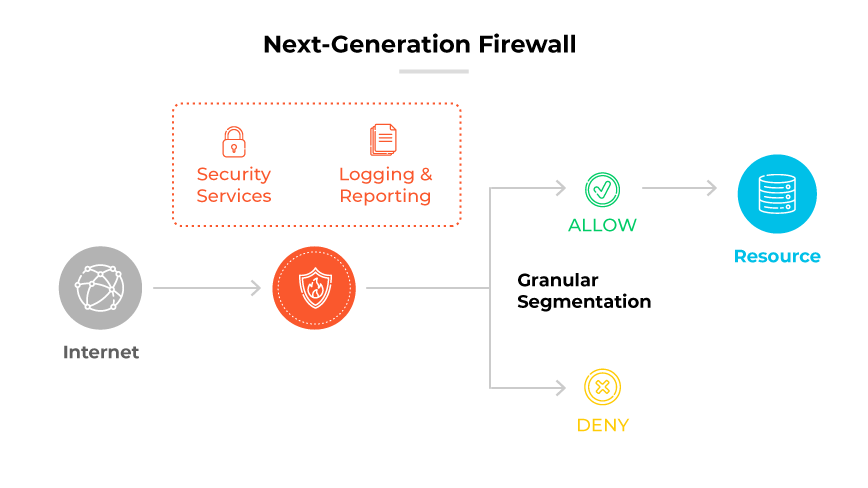
Next-Generation Firewalls (NGFWs) offer comprehensive security features that go beyond traditional firewalls by incorporating advanced inspection capabilities, application awareness, and threat intelligence. They analyze traffic at a deeper level to protect against complex, modern threats.
Types of Firewalls Defined and Explained
Network Firewalls vs. Host-Based Firewalls
Network firewalls are designed to shield the network by filtering traffic that enters or leaves through network borders. They enforce security policies across network infrastructure, assessing data packets at various levels to prevent unauthorized access. These firewalls are often placed at strategic points within the network to inspect and manage the flow of traffic, detecting and preventing external threats.
Host-based firewalls, on the other hand, are installed on individual devices within the network. They provide granular control over the incoming and outgoing network traffic of their host device. Unlike network firewalls that protect the perimeter, host-based firewalls offer a second layer of defense, managing traffic at the device level and preventing the execution of harmful applications or the exploitation of vulnerabilities within individual systems.
The integration of both network and host-based firewalls in an enterprise setting offers a layered network security solution. While network firewalls serve as the first line of defense against attacks that target the network at large, host-based firewalls add depth to security protocols by securing internal traffic and providing endpoint protection.
